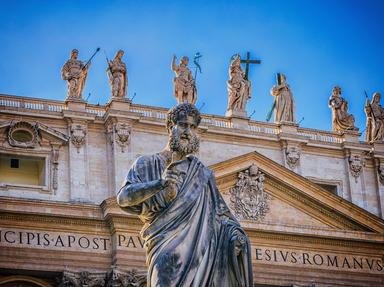Quiz Answer Key and Fun Facts
1. This Galilean fisherman was a disciple of John the Baptist, and was the first to be called by Christ. According to tradition, he preached in Asia Minor and in Greece, where he was crucified on an X-shaped cross. He is the patron of Greece, as well as of Russia and Scotland.
2. This apostle was named Simon, but Jesus bestowed upon him another name meaning "rock". In the gospel of Matthew, he proclaimed that Jesus was "...the Christ, the Son of the living God", upon which Jesus declared that he would be the foundation of the church and possess the keys of the Kingdom of Heaven. In this same chapter, however, Jesus addresses him as Satan when he reacts with horror at the idea of Jesus' being put to death.
3. This apostle was a fisherman and the brother of the apostle John. He and his brother were nicknamed "Boanerges" (meaning "sons of thunder") by Christ because of their bold statements and fierce temperaments. He was present at the raising of Jairus' daughter from the dead, and was one of only three apostles to witness the Transfiguration. He was beheaded by order of Herod Agrippa I; the first of the apostles to suffer martyrdom, and the only one (apart from Judas) whose death is mentioned in the New Testament (Acts of the Apostles 12:1-2).
4. This apostle is the author of the fourth gospel, as well as the Book of Revelation and three epistles. In his gospel, he alludes to himself as "the apostle whom Jesus loved." He was the only apostle present at the Crucifixion, and is believed to be the only apostle not to have died a martyr.
5. A tax collector, this apostle was also known as Levi. He is credited as the author of the first Gospel.
6. This apostle is mentioned in the gospels of Matthew and Mark as one of the "brothers of the Lord". According to the Acts of the Apostles, he was highly regarded by both Peter and Paul, and was apparently the head of the early church in Jerusalem.
7. This apostle was present at the distribution of the loaves and fishes. At the Last Supper, he asked Christ to "...show us the Father."
8. This apostle was also known as Nathaniel, and was introduced to Christ by Philip. Jesus called him "A true Israelite, in whom there is no guile"
9. This apostle is also known as Thaddeus. He has occasionally been confused with a more notorious apostle with a similar name.
10. Surnamed "The Zealous", this apostle may have been Jesus' first cousin, or even his brother. He is believed to have preached in Egypt and Mesopotamia, and to have witnessed both the persecutions of the Christians, and an attempted extermination of the Jews.
11. Also known as Didymus (the twin), this apostle was present at the resurrection of Lazarus, but refused to believe in Jesus' own resurrection until he could place his fingers into the holes left by the nails and spear. According to tradition, he preached in Parthia and in India, of which he is patron.
12. This apostle was probably the only one of the Twelve who did not hail from Galilee. This factor might have created a sense of alienation from the others, which may have influenced his actions, as described in the gospels.
13. This disciple was chosen by the remaining apostles to take the place of Judas, after the latter's suicide.
14. The King James version of the Bible, as well as several other versions (including the approved Catholic editions) includes seven epistles written by four of the original twelve apostles, in addition to the epistles of St. Paul. Who are the four apostles credited with having written these epistles?
15. Three of the people associated with Jesus are described in the Gospels as "brothers (or brethren) of the Lord"; which three?
Source: Author
jouen58
This quiz was reviewed by FunTrivia editor
gtho4 before going online.
Any errors found in FunTrivia content are routinely corrected through our feedback system.


